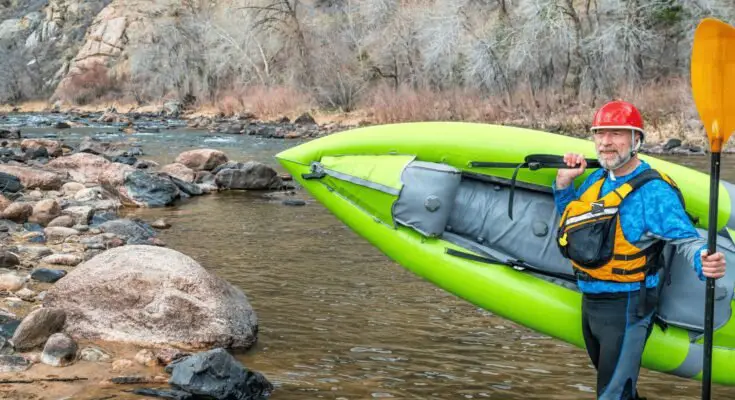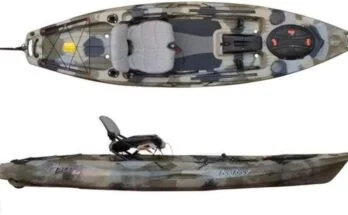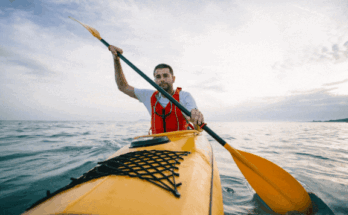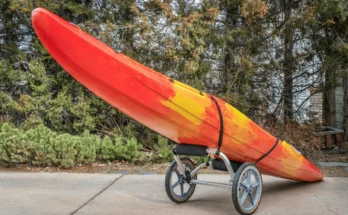If you are the type to drive around, see the waters to be explored, and pull up and launch your kayak, then it has to be one you can comfortably lift single-handedly. In addition, weight can influence the level and strength of the energy or force applied when paddling a canoe.
The most appropriate specific lightweight kayaks will make the transportation into and out of water as convenient as possible. That must sound quite familiar; it is always fun to get out on the water and make a tour not expending too much energy. But I have to say that it is very inconvenient to carry a big boat around before and after the trip for kayaking.
Some kayaks are easier to maneuver in and out of the water, and recognizing this means you are more likely to use the kayak. That’s the reality, it is as straightforward as that.
Now, from the weight of the events, can we conclude that this is the only critical factor?
Well, let us look at these questions, and more importantly, how do you select the best lightweight kayaks?
To save time and give you an overview of lightweight kayaks, here are the facts that you need to know.

Why Choose a Lightweight Kayak?
Based on the factors above, no two boats are perfectly suitable for a given purchaser though some benefits are accorded to persons who opt for lightweight Kayaks over traditional bulky ones. It also has transportability, which is a significant aspect. Ideally, you would like to be able to carry the kayak from your car to the water either alone or with a friend without much strain.
Further, while the majority of these light kayaks can be carried without a hitch, many don’t even need to be placed on the roof rack of your car. Among the inflatable kayaks, there are folding kayaks and these are even less bulky and more diverse in their size and shape. Chunk them into the boot of your car. Some of them can be folded into the case they came with and therefore used as checked luggage while traveling.
One must always see the need to use lightweight kayaks that keeps the paddler interested in venturing to new areas. Sometimes, having a bulky and large kayak may push you to the edge of deciding to pull it up to some distant lake. These best lightweight kayaks can be carried to more distant lakes or archipelagos you always wanted to explore.
With these, we want to state that lightweight kayaks cannot be used for sea kayaking or paddling through rough river rapids. To practice sea kayaking you will need to use a sea kayak, while for River kayaking, the kind of kayak to use depends on the level of rapids that you intend to do. For those who are just starting, have not been recently kayaking, or are just starting on a new type of kayak
If you turn them over or fall out, a lighter vessel is a little easier to right as well. As for me, I am yet to have my kayak flip and it isn’t too big of a deal if it does so they say. Again, you will also find that you can get up to speed much faster when paddling a lightweight kayaks compared to a heavy one because there is less weight to deal with on the water.
What Makes A Kayak Light?

The definition of lightweight kayaks: How can we decide whether a particular kayak is lightweight or not? Where is the line wherein Wismar becomes heavy and Zwickau light, where did they put the dividing weights?
Although, it is difficult to categorize and determine kayaks with weight of less than 50 pounds as lightweight kayaks, a general reflection could tend towards this yardstick.
Sometimes I get queries such as; which sit on top kayak is light or which is the lightest sit on top kayak?
Unfortunately, there is no common answer and it is more dependent on several issues.
On that note, let’s take a closer look at the elements or factors making a kayak light in the following ways.
Types of Kayak and Their Use
To start, there is the issue of where you will be using your kayak whether it is recreational or for hunting. Your choice of kayak depends on the intended usage; if it’s for recreational use on mild water – rivers, lakes, and bays then a lightweight kayak is perfect. For this particular activity, if you are going to go sea kayaking or ocean kayaking, I would probably invest in a more sturdy and durable kind of boat that can endure the strong pounding of the sea. The same goes for any abilities, and what about whitewater kayaking?
Recreational Kayaks
Recreation kayaks are versatile all-around boats designed to be used for recreational purposes on lakes and the calmest river waters. Keel: Most of the kayaks in this list are for recreational use and therefore do not come with the traditional keel found in sea kayaks. These are not the kind of kayak you strive to acquire in case you will be using it to maneuver in the sea, ocean, or difficult rapids. This list of the top-most lightweight kayaks includes only recreational kayaks though the model displayed is not light enough to go through ocean waves and whitewater rapids.
Sea Kayaks
Sea kayaks are designed to perform and glide through and over ocean waves. These kayaks are also longer and thinner than the other types of kayaks in addition to being fitted with rudders or skegs. It can be proven that these ships are designed to offer preliminary protection against windy and more challenging conditions. Lightweight sea kayaks exist though they are a bit rare in the market as compared to the recreational types of kayaks. As they can be tandem kayaks as you actually should not paddle through the sea alone.
Whitewater Kayaks
Whitewater kayaks are the designs that are available in the market to target the whitewater rapids. For those willing to embark on white-water kayaking, do not attempt to do this with a recreational kayak! Whitewater kayaks are hard and they are mostly compact. There are still some that have been created for use in white water rafting or in other words the rapids.
Inflatable Vs. Hard-Shell
There are several changes a paddler can make to keep things light while paddling a traditional kayak, however if you prefer a hard-shell kayak, picking the right one can do the trick for you. But some astounding hard-shell kayaks could also be considered lightweight – scroll down to learn more.
But that doesn’t mean that inflatables aren’t worth considering:
Compared to other classes of water crafts, inflatable kayaks are quite portable, easy to store and very compact. If your planning to take your kayak along with you and hike through the wilderness, or use the kayak, there are inflatable options
Hard Shell Kayaks
Hard shell kayaks are commonly the ‘conventional’ type of kayaks that you are likely to come across when you are hiring a kayak from a tour guide or any Kayak service provider. Either they are of plastic make or made up of fiberglass. Normally, the hard shell kayaks will be heavier than the inflatable/foldable ones, though these types may be lighter in the long run but won’t perform well in comparison to the former.
Inflatable Kayaks
Inflatable kayaks have a couple of key advantages: they are also extremely portable and take up little space, and frequently, they cost even less than any of the other types. Even though it is much cheaper, it may not be as efficient in handling water as those with hard shells or foldable kayaks. But HOBs have evolved quite a lot over the years, and these kayaks that are in the list do float quite well.
You will also have to inflate them every time before you start using them and so you find it will just take a little bit more of your time. Using an inflatable boat means that there is a high possibility that your inflatable kayak does not come with a built-in pump. A few blow-up kayaks come with a pump; however, most of them require you to buy the pump individually. First and foremost, ensure that the pump you are going to get integrates with your kayak.
Construction Materials
This means choosing between the hard shell or the inflatable kayak, which is important even before taking into consideration the material required.
Generally speaking, though, most lightweight kayaks are constructed using some type of plastic:
- Hard-shell kayaks are usually constructed out of high-density polyethylene, a type of hard, durable, and often UV-resistant plastic. Composite materials are also an option, although a far more expensive one.
- Inflatable kayaks which are more lightweight by design – are most commonly made of PVC.
Dimensions (Length & Width)
The cross-sectional area of the hull decides the carrying capacity of the kayak, and the latter increases its weight no matter the material used in construction.
It pays to refer to the old saying “You Can’t Judge a Book by its Cover” Nigerian qualified lawyers are not different from other legal professionals in Nigeria in this regard.
When looking for lightweight kayaks, you might be tempted to go as compact as possible, but before you do, keep in mind that dimensions – primarily length and width – play into the kayak’s on-water performance:
Long and slim is much more suitable for long-distance paddling; short is much better for maneuvering through whitewater rapids; and wide ones provide more stability.
However, you need to ensure the size of the kayak accommodates your size – including if means acquiring a somewhat larger kayak.
A word of caution to beginners, owning a kitchen scale is misleading while choosing a kayak – I’ve come across so many 12 inflatables that are lighter than an 8-foot hard shell. But as for the given rule of thumb, then, yes, if the two things are made from a similar type of material the smaller thing will also be lighter in weight!
Here are the Best Lightweight Kayaks
Here is a list of what we think are some of the lightest kayaks available to buy on the market today. I have offered ten lovely kayaks in total, beginning with the lightest kayak mostly required for single persons; then the finest lightweight kayaks for two people. Well, without any further ado, here are some types of recreational kayaks that you can get for your consideration for when you embark on your next hike adventure spree.
1. Advanced Elements AdvancedFrame Inflatable Kayak
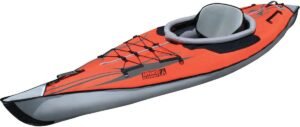
SPECS:
- Weight: 36 lbs
- Length: 10′5″
- Max Capacity: 300 lbs
If one has to have a short idea about why or where the Advanced Elements Advanced Frame Inflatable Kayak is the best lightweight kayaks out there, here are the ways. This type of kayak incorporates some attributes of a fold-frame kayak and another part of an inflatable kayak.
The design is sleek and lightweight that even an adult does not have to assemble it. While it may not be exactly compact, all you have to do is extend the kayak, fit in the pump, and blow the kayak and you are ready for the paddling.
The Advanced Elements AdvancedFrame Inflatable Kayak is collapsible and hence can be carried in small spaces of 30X17X10 inches meaning that you will carry it anywhere. Even so, this is a lightweight paddle kayak that is constructed with premium durable materials.
It is built using its PMC Hull Material, which is a polyester fabric with multiple layers of PVC vinyl to create a very sturdy fabric. The model’s rigid aluminum frame reinforced in the bow means that you can push it through the water with ease thanks to the aluminum frame reinforced in the stern that performs the function of a skeg that enhances the tracking performance of the model.
I find this particular kayak to be rather commodious and the room for the legs, as well as storage compartments, provided is more than sufficient. Also, there is an easily removable chair that is padded and very comfortable, so you will be able to spend hours padding without dripping with sweat. Everyone likes this one as one of the most efficient lightweight kayaks and one of the best inflatable kayaks you can find.
2. Pelican Maxim 100X

SPECS
- RAM-X polyethylene hard-shell construction
- Measures 10 x 2.3 feet
- Weighs 36 pounds
- 275-pound capacity
To begin my list, let me start with one of the all-around favorites for the hard-shell kayaks, thus marking the ‘yes’ to those looking for lightweight kayaks.
with RAM-X construction, this sit-inside in particular measures 10 feet and although it is long, it does not necessarily weigh a hefty 36 pounds. Also, it has a fair amount of lifting power for a lightweight chair that is 275 pounds.
Something that the Maxim 100X also has is a couple of storage solutions in terms of containers; a tank well and a hatch, though not a large one, and not waterproof.
These features include a padded seat, foot braces, and molded footrests which make the comfort of the paddle improve though I noted that the adjustments of some components of the kayak on the water are somewhat challenging.
3. Pelican Sentinel 100X
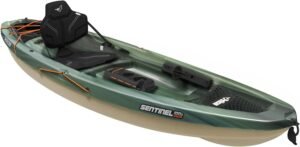
SPECS
- RAM-X polyethylene hard-shell construction (high-density polyethylene)
- Measures 9.5 x 2.5 feet
- Weighs 44 pounds
- pound capacity
This is another of the Pelican kayaks that you may consider preferably the Pelican 9-Feet-Ideal. The Milly features a sit-on-top, hard shell and measures 5 feet in length, making it enticing to kayak anglers.
The Sentinel 100X is built to perform using RAM-X polyethylene – the high-density polyethylene that is exclusive to Pelican – but is slightly heavier than the Maxim 100X at 44 lbs.
The slight difference in weight stems from the Sentinel 100X’s fully rigged design:
Intended as a fishing kayak, the cockpit comes equipped with mesh bow storage, tubes for multiple rod holders, accessory eyelets, as well as the ExoPak storable storage hatch which fits into the tank.
Designed for fishing purposes; it comes with a mesh bow storage area, tubes for rod holders features, an ExoPak storable storage tank, and mesh storage eyelets.
It comes with a 275-pound capacity, which seemed quite a bit low given the amount of equipment fishers carry around.
It is a strong contender with the answer to the question, whatsit on top kayak is the lightest?
Believe it or not, it is probably amongst the lightest fishing kayaks available on the market – at least I think it is. However, you get the drifting; for a fishing kayak, it is astoundingly lightweight.
4. Lifetime Lotus Sit-On-Top Kayak
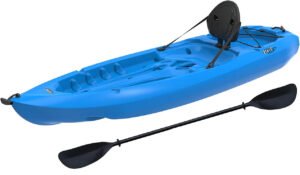
SPECS
- Weight: 38 lbs
- Length: 8′
- Max Capacity: 250 lbs
There are several small sit-and-on kayaks available that you may be interested in. It is a sit-on-top kayak that measures only 8 feet long making it a perfect kayak under 10 feet, manufactured by Lifetime. In case you’re ordering just one kayak or two, there is the choice to buy it singly or in a set that contains two pieces if you and your friend are one in spirit for the voyage.
Certainly, there are several benefits that the angler can discover in Lifetime Lotus Sit-on-Top Kayak. First, its design assures magnificent stability and tracking. It also has a rating system which makes it easier for users to understand the contents better It also comes with a paddle so the extra purchase is unnecessary many of the kayaks that we have listed here do not come with a paddle.
Enclosures on the area of the cockpit have been drilled with drainage holes as a mechanism to avoid the accumulation of water in the area. There is a large storage consisting of baskets, ropes, and a bungee cord where you can secure all your things. The kayak is also constructed out of high-density Polyethylene and features a UV protectant so that it does not crack and peel like some other plastic kayaks, and it also comes with a 5-year warranty.
5. Wilderness Systems Pungo 120 Kayak

SPECS
- Weight: 49 lbs
- Length: 12’2″
- Max Capacity: 325 lbs
The Wilderness Systems Pungo 120 Kayak is an excellent example of a well-built light kayak that is one of the longest on this list. I have observed that it offers superb performance as far as fishing is concerned because in terms of speed and stability, it excels and most importantly when it comes to living standards, it offers the best. This kayak is stable and allows canoeing with less effort.
The manufacturers have paid attention to details when it comes to the size of this product right from its thigh pads to the slide lock XL adjustable foot braces. This Phase 3 AirPro seating system has patents that help to support your lower back as you paddle. As much as it is a bit heavy, among the light kayaks, it is easy to carry due to the rigid handles installed on the kayak.
It makes you wonder if they have also considered all these little elements. I have a small healthy compartment with a screwed-up door that offers dry compartments. Two mounting platforms will allow you to mount a phone or a camera. There are even cup holders and a removable dry box.
- The molded cockpit with a swim-up deck makes re-entry easier
- Bright color improves on-water visibility
- Excellent stability
- Youth-sized paddle included
6. Aquaglide Deschutes 130 Inflatable Kayak

SPECS
- Weight: 21 lbs
- Length: 13″
- Max Capacity: 400 lbs
This is not the ordinary blow-up raft that you can buy from any supermarket in the neighborhood. Well, what a piece of kit the Aquaglide Deschutes 130 Inflatable Kayak is, it’s a comfortable day touring kayak that only weighs 21 pounds with a maximum load-carrying capacity of 400 pounds. One thing that I liked about the boat from an engineering perspective was its tracker; it is long and narrow making it great for tracking and you move so smoothly on the water.
It can be made of Duratex reinforced PVC, and a FeatherFrame crosspiece support construction which gives it rigidity without metal components like heavy aluminum frames. This seat is equipped with both a lying cushion and a firm back providing continuous air circulation (ideal for hot weather).
This is the beauty of this product; you will easily assemble this kayak, and you’ll be ready to use it within minutes. Take it out of the bag, fill it up with air into the three chambers, and one is ready to go. The cockpit of the kayak is very open, and it is easy to get in and out of, in addition, the splash guards in front of the bow and at the back of the kayak protect clothing from getting wet.
These front and rear bungees will enable you to bundle different items that you want to have with you while on your kayak trip. This particular product is one of the best inflatable kayaks which may have you thinking…. hard-shell kayak who?
7. Lifetime Youth Wave Kayak
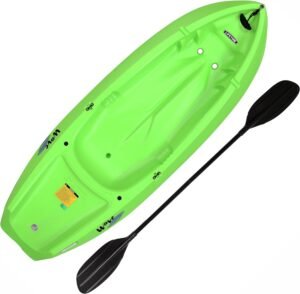
SPECS
- High Density Polyethylene hard-shell construction
- Measures 6 x 2 feet
- Weighs 18 pounds
- pound capacity
It turns out that the LW gang is as light as hard shell yaks come, Youth Wave’s coming in at 18 pounds. It won’t fit 95% of adults reading this, especially not considering the 130-pound capacity, but that’s the point:It won’t fit 95% of adults reading this, especially not considering the 130-pound capacity, but that’s the point:
The sit-on-top constructed for this ship is intended for the young!
The scientifically designed cockpit with a swim-up step ensures a slippery and easy entry; moreover, the footwell has several positions, but the overall look is fairly minimalist and lacks style details. Not that it has a soft cushioned seat at the back of it.
On the other hand, I assumed that kids would not miss it in the first place for whatever reason I could give to support this argument. It allows kids to have fun in this highly-stable, brightly-colored kayak – that alone should be enough for children to have fun deprived of a day on the water.
8. ADVANCED ELEMENTS Lagoon 1 Kayak
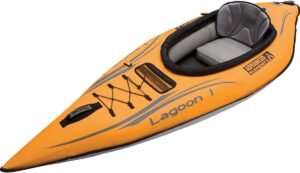
SPECS
- PVC-coated nylon inflatable construction
- Measures 8.3 x 2.8 feet
- Weighs 23 pounds
- 250-pound capacity
About inflatable kayaks: This is lightweight construction and high portability; factors well illustrated by the Advanced Elements Lagoon 1.
This 8. The 3-foot sit-inside kayak is light-featured and weighs about 23 pounds. This is because it depends on the winds and the choppiness of the water surrounding the vessel. Nevertheless, it is robust and we can tell it was designed to be sturdy – and the six chambers give added insurance.
With a capacity of up to 250 pounds, I was not shocked to find that the storage spaces available were the bungee rigging and mesh pocket. It should be sufficient if you only use it from time to time for such things as watching movies, playing games, or downloading music.
All in all, speaking as a regular paddler; I believe it is worth it but a conventional paddler may not be inclined to pay so much for an inflatable kayak.
9. ADVANCED ELEMENTS AirFusion Elite Kayak
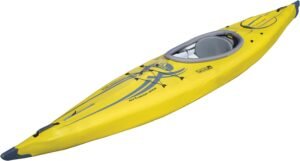
SPECS
- Polyurethane and aluminum hybrid construction
- Measures 13 x 2 feet
- Weighs 32 pounds
- pound capacity
It’s neither a hard-shell nor an inflatable – instead, the Advanced Elements AirFusion is a little bit of both
It does not come close to a hard-shell model or an inflatable kite model but it comes with the best of both worlds :
This incorporates an aluminum frame and a polyurethane skin that is stretched over a shell of a vehicle having a length of 13 feet is connected to the frame with the help of inflatable cylinders filled with high-pressure air. But the design is a perfect fit in how this yak steers and reacts so well out here, I just got it though it ‘feels’ like padding a hard hard hardshell, the two are not very much different in the way they perform.
There will be a small increase in a kayak’s weight, ranging from 32 pounds to 38 pounds but what you get are primary and secondary stability and weight divided in half. From the weight of this particular model, it would trump all the kayaks presently in the market and you can only imagine how light this was if it were to be a hardshell.
Concerning the storage feature, Shs come equipped with bungee deck lacing, the rear roll-top hatch, and D-ring tie-downs. Nevertheless, it only offers a 235-pound maximum weight which implies that users should not stuff it with items each time they use it.
The last device on my list is the AirFusion Elite, which is the most costly among all the gadgets I have listed Above cost is not very prohibitive but I don’t really love this aspect. This is, however, quite affordable when compared to other foldable kayaks in the market in terms of pricing.
10. Sevylor Quikpak K1 1-Person Kayak
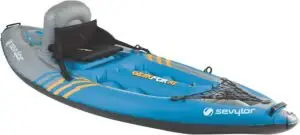
SPECS
- 21-gauge PVC inflatable construction
- Measures 8.6 x 3 feet
- Weighs 18 pounds
- 400-pound capacity
Can you imagine that you wake up one morning, take a backpack, and you go to the lakeside – and voilà within five minutes, the backpack has become a kayak?
Let me introduce you to the Sevylor Quikpak K1
The whole thing – the 8-minute animation – is entertaining and engaging with bright colors and characteristically eccentric writing and voice-over. The Outdoorsman version is a 6-foot sit-on-top inflatable kayak in one package, a collapsible paddle, and a pump that makes 18 pounds resemble a functional watercraft. Not only that but the particular bag can also be easily converted into a seat.
I also like the concept of the multi-chamber Taylormade design and I was amazed by the 400 pound’s capacity.
Its speed and tracking are as appalling as the paddle – but still, it is not bad for a leisurely kayaking session.
11. Sevylor Quikpak K5 1-Person Kayak
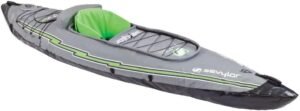
SPECS
- 24-gauge PVC inflatable construction
- Measures 10 x 2.8 feet
- Weighs 25.5 pounds
- 250-pound capacity
Another backpack kayaking system is the Sevylor Quikpak K5 which is suitable for those who carry their gear around, this saves on space greatly.
Pictured to the left is a somewhat frail 10-foot, sit-inside inflatable kayak, the flimsy three-piece paddle, and the kayak pump constitute a 25. seat and spray covers: This lightweight product comes in the form of a small 5-pound backpack that transforms into the seat once unpacked.
As we have already mentioned, the K5 is a sit-inside kayak, whereas the K1 and Key West are sit-on-top models. As with the K1, this sit-in kayak comes in a streamlined, compact package and can easily be taken on a plane; all you have to do is remove the water chamber for airport security, and it can be taken as check-in luggage.
There are some welcome additions and changes to the K1 for this 2012 model though: the 24-gauge PVC construction and cargo space are a step up on the previous version but it drops the capacity to a more measly 250 pounds total. I wouldn’t necessarily recommend it to larger paddlers; however, sturdy-built persons can easily maneuver it.
12. Intex Challenger K1 Kayak
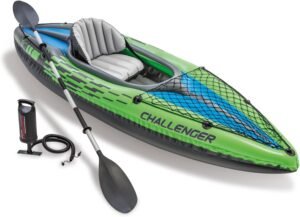
SPECS
- Vinyl inflatable construction
- Measures 9 x 2.5 feet
- Weighs 27.2 pounds
- 220-pound capacity
At least with regards to the Challenger K1, it is necessary to admit that for a product of this class – an inexpensive inflatable kayak – it looks quite cool. Furthermore, the graphics adopted in the gadget enhance it has sporty touch and augment the visibility significantly.
This three-layered sit-on-top kayak measures 9 ft long and has a comfortable weight of 27 lb. 2 pounds meaning that if you put into the fridge something that weighs more than 220 pounds, it will have to shift that mass voluntarily. Therefore, it is better suited to those who are not large or who don’t plan on carrying a lot of gear. Even though it comes with a cargo net, I believe that you will not be carrying stiff’s many pieces of equipment because of such constraints.
Some of the features that I found interesting include the fact that the Challenger K1 comes as a whole kit, that has a pump, a carry bag, a paddle, and a repair patch.
13. Sea Eagle Sport Kayak
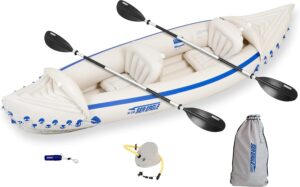
SPECS
- Weight: 26 lbs
- Length: 11′
- Max Capacity: 500 lbs
Is this America’s most popular kayak? In its turn, Sea Eagle has said that their Sea Eagle Sport Kayak is the lightest and most portable model, which is also famous for being the most beloved by Americans. Another issue that we have intentionally focused on with this rugged kayak was to design it with great portability in mind so that it could be taken and used by two people or carried by only one in case of a need to.
Some of its best features include Two skegs at the bottom to enhance tracking and speed, inflatable spray skirts, a material made of sun and saltwater, a bow, and a stern grab line. This one also comes in handy while white-water rafting and is capable of handling rapids of up to class III.
Here, and only here, are more extra features. On the Sea Eagle website and on Amazon, they were presenting packages that had the kayak, paddles, inflatable seat, foot pump, repair kit, and bag. This is one of the excellent models of high-end lightweight kayaks and is inflatable and folds for carrying and storage. It is a Novice recreational kayak or a recreational kayak for the rocky river running, and kayaking the rapids.
14. Explorer K2 Kayak
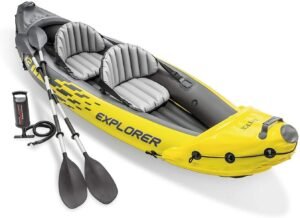
SPECS
- Weight: 30 lbs
- Length: 10’3″
- Max Capacity: 400 lbs
The Explorer K2 Kayak is probably one of the cheapest kayaks that one can find on the market, so if you are just getting into kayaking (or you simply love trying out different models), you don’t have to spend a lot (it will only set you back roughly $100) to get your feet wet… or to be more accurate – in water. This is a comfortable kayak for anyone because it is vintage and does not have to be assembled. they have an adjustment for an inflatable seat with a backrest and a large cockpit.
Thus it is made with heavy-duty puncture-resistant vinyl It is made with heavy-duty, puncture-resistant vinyl It is made from heavy-duty puncture-resistant vinyl. Among its key features, we can list three individual air chambers and an I-beam inflation floor for enhanced rigidity. However, there is a recessed skeg – a contingent that can be removed – as well as a grab line at both bow and stern.
Explorer K2 Kayak is an Open-water recreational kayak that can be used for leisure paddling on gentle lakes and rivers. This one could be really fun to take out on the water for a few hours one day too. It makes it suitable for use during one’s spare time like during holidays and other such activities since one just has to toss this one at the back of a car. It’s a good budget kayak that can make you reconsider a full composite kayak.
15. Oru Kayak Inlet Folding Kayak – 10′
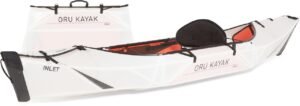
SPECS
- Weight: 20 lbs
- Length: 10′
- Max Capacity: 275 lbs
At least two of the best lightweight kayaks on the market have been made by Oru Kayak and for good reason. These are the Oru Kayak Inlet models, the world’s lightest and most compact folding kayaks. It collapses into a box measuring 40x19x10 inches and conversion from box to a ship takes 3 minutes at most.
Unlike those conventional kayaks that mess up your style while you are in the process of carrying them to your favorite section of the water, this one is very portable. Charge this faraway Alpine Lake, no issues! One positive aspect of the Oru Kayak Inlet that I must note is that simply, it is not an inflatable kayak. It just folds and you are ready for it.
The Oru Kayak Inlet comes with a quality design that is stylish, safe, and tough, and its body is made from 5mm double-layer polypropylene, extruded own brand. This is manufacturer-rated for 20,000 folds and complies with the USCG Reacreationalty Vessel standard. It is ideal for use in shallow and flat water such as bays and rivers; and rather appropriate for first-timers as well as experienced ones.
Perhaps you are familiar with Oru Kayaks from a well-known reality show, Shark Tank, the popular business magazine Forbes or any of other numerous resources like CNN, Wall Street Journal, or Oprah Magazine. It is a small business brand and they support the manufactured product with a twelve-month warranty and 30-day money-back guarantee. There is no reason you shouldn’t try this one for it can only give you beneficial results.
Best Lightweight Kayaks Buying Guide: How To Choose A Lightweight Kayak
You might have expected to come here and start daydreaming about picking a kayak that has the least weight possible into the water.
Of course, you are going to want to choose something that will be within your more limited weight capacity. For example, I may claim that it should be quite easy to carry a load of 50 pounds or less for most paddle excursionists.
However, there’s more to it than a simple:
How heavy is it? “
Well, I guess you do expect the best lightweight kayaks to be… er, light ones, which is pretty obvious anyway. But weight (and everything related to it) aside, you also want it to be comfortable – that is, fully functional – kayak.
A likely scenario where a buyer approaches the market with a lightweight kayaks shell in mind is the following question: and what good is such a hull if it will compromise on-water performance?
In light of the above, the following factors are critical in the selection of a lightweight kayaks.
Let’s Talk Comfort: Always Look For Adjustability
The main focus is to delete as many pounds from the overall weight of the kayak – but without sacrificing the comfort associated amenities.
The thought process of drawing it to the present for a while makes one want it to be comfortable if you are to spend your time in it.
It is especially important if you intend to go for a longer period, as comfort here becomes a question of how your body is being supported and how well you can maneuver the kayak.
The critical thing to look for here is adjustability:
Height adjustment, calf supports, thigh supports – anything that will give you even better-adjusting options you welcome.
In my case, the size is important because I can comfortably be considered as a plus size gal so the next thing to consider would be the size of the cockpit. It’s quite maddening to get a kayak that you physically cannot – and I don’t mean benignly, metaphorically – get into due to size.
Don’t Underestimate The Need For Onboard Storage
In a way, the capacity of rush storage depends more upon the subject’s inclination – with an important provision taken into account: beloved kayaking practices.
Of course, tomorrow you want it to be rather airy. It does not necessarily mean that for a day out in the water, it means that you do not require other basic equipment such as a life jacket/PFD and a paddle.
Things like food, water, first aid essentials, spare clothes, sunscreen, or any other general items that you may want within your reach should be kept in your kayak at all times.
But how do you intend to store those if the kayak lacks compartments to hold them?
One is likely to discover multiple hatches or large tank wells missing in a lightweight kayak.
But it should have room to store some things in a dry area, at least the smaller items; some places to tie things down; the bungee rigging; and maybe an extra space behind or beneath the bench seat.
Do Lightweight Kayaks Have Low Weight Capacity?

It’s always wise to look at the weight it can support, whether you’re opting for a 100lb hardshell or a 20lb inflatable. It is an indication of how maneuverable the kayak will be when loaded not just with your ‘payload’ but whatever accessories you may decide to incorporate.
What average kayak weight for a man might be way below that of the other model, using a light kayak does not necessarily imply that the kayak cannot hold much weight.
Well, at least not as dramatic as could be expected, given the less stringent construction that was described.
Look at inflatable kayaks, for example
They average at about 1.5 meters in body measurement and about 25 to 30 pounds in weight; however, they can easily compete with the bulkier hard shells in terms of load-bearing capacity.
Portability & Storage As Common Concerns
Perhaps quite expectedly or unexpectedly, the size and weight of an average kayak are some of the basic things that many people encounter as a concern when they are seeking to purchase their first kayak.
You also have to consider how to carry the kayak to the water surface or to the shore when it is off the water, which may need roof racks or kayak trailers.
Plus also remember that there are occasions where one may be required to transport or portage the kayak due to passing through obstacles such as low head dams.
Finally, one must have some storage space at home; a full-sized kayak is not an item that you put on the shelf and then never even think about it.
That is when a lightweight kayaks is the most effective – and of course, the inflatables don out the hard shells.
In all circumstances ensure it is fitted with carry handles, grab lines, and T handles, and if the kayak is inflatable, it should come with a storage bag.
The Verdict: What are the Best Lightweight Kayaks?
I believe that you previously limited your options to the lighter designs due to some of the factors like lack of storage space, transport issues, or inability to handle a modern, standard-size kayak all by yourself.
In any case, I had to present you my best overall, as well as my best inflatable, hard-shell, and ARC lightweight kayaks that all of you still have numerous choices to turn to.
This time, my vote goes to the Pelican Maxim 100X:
It is very strong and rigid but at the same time, it is portable – more so than most of the hard-shell designs can provide and it is more than capable of giving good performance on the water. Not only that, idling is excellent for long paddles, as the seats are designed in such a manner as to provide comfort and support throughout.
For those of you who would like to get the inflatable kayak due to space constraints, you can purchase any of the kayak models that I have stated above. I am quite confident that you will make the best choice and will be happy with your decision.

